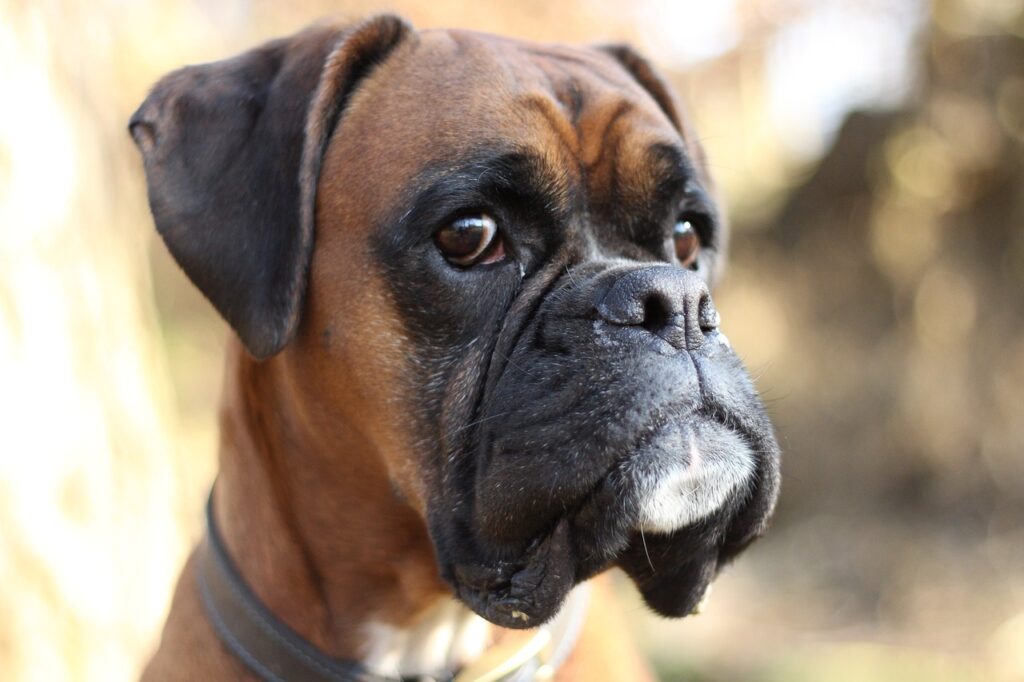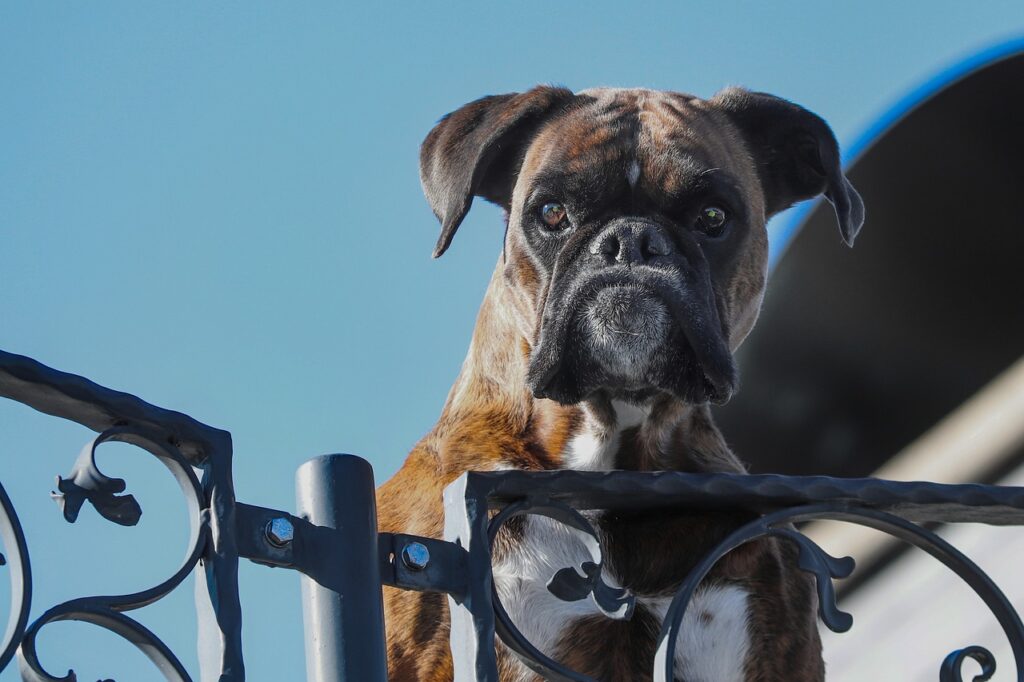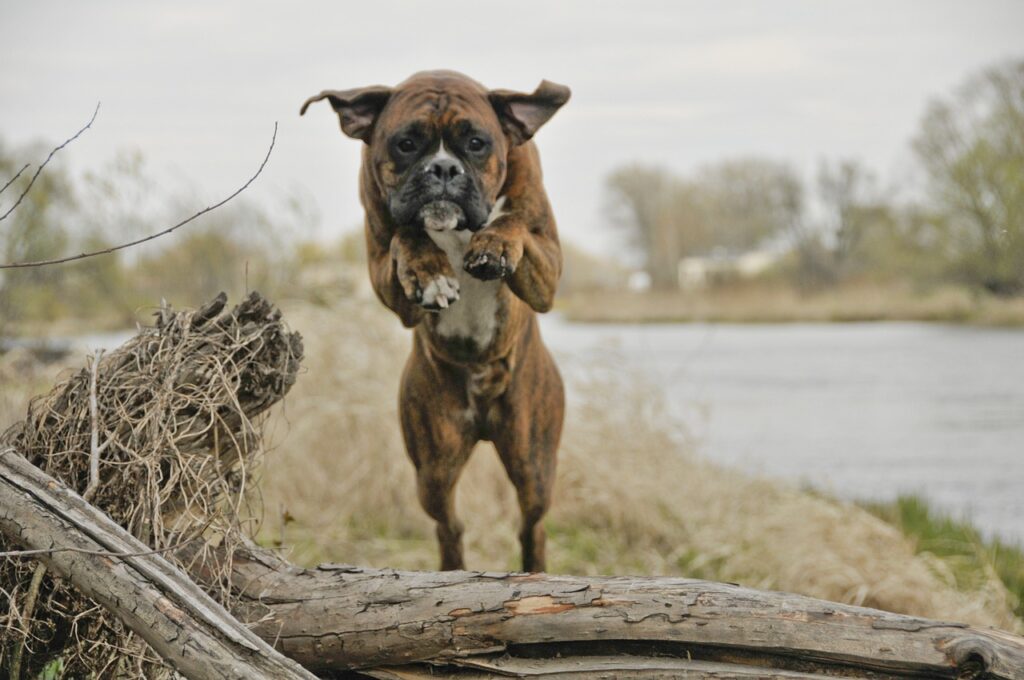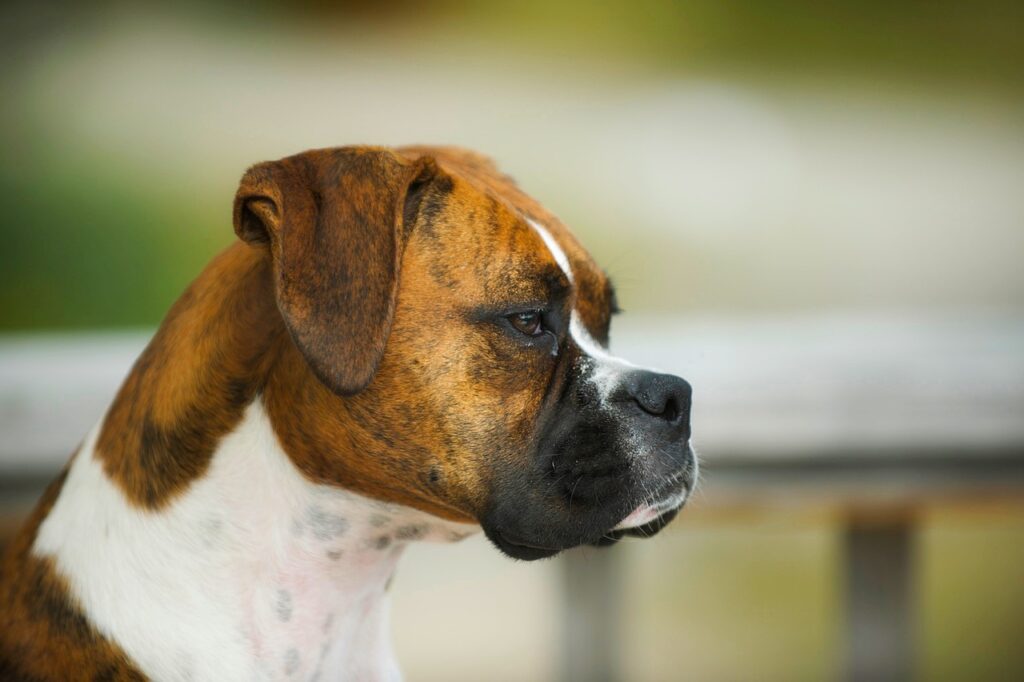The Boxer dog name has two possible origins. Some believe it comes from the Bullenbeisser, a German dog from which the Boxer was bred. Others believe the boxer dog origin comes from its fondness for ‘boxing’, standing up on its hind legs and ‘boxing’ with its front paws while playing.
Why are Boxers called Boxers?
The origin of the name of Boxer dogs is disputed. On the one hand, it could be handed down from their ancestors, the powerful Bullenbeisser. But it could also be because they love to ‘box’ with their front paws. When playing, boxers will use their front legs to spar with their opposite number like human boxers in the ring. It is incredibly cute.
There are a number of other hypotheses. One of the more obscure ones is that ‘Boxer’ was the name of a dog in The Cricket on the Hearth, a famous book by Charles Dickens from 1845. The theory goes, ‘Boxer’ was a common dog’s name shortly before the time the Boxer breed started to become established in Europe. It seems unlikely but you never know.
Another suggestion we’ve come across claims that the Boxer dog name comes from their role as butcher’s assistants back in the 19th century. The Boxer breed was used to help herd cattle in slaughterhouses and some believe that Boxers are named from the German word boxl – which was the name given to these dogs of the slaughterhouse. In fact, this might actually be the most plausible explanation of the boxer dog name. That’s because, as we discuss in more detail below, the boxer dog origin comes from a particular breed of the Bullenbeisser – the Brabant Bullenbeisser. There is a school of thought that these dogs were known as ‘Boxl’, with Boxer being an English language corruption of this word.
A similar theory that also holds some weight claims a group of dogs in Munich were known as ‘Bierboxer’. This occurred around the time that Boxers started to be bred in southern Germany. ‘Bier’ could refer to the ‘Biergarten’ – a typical Munich beer garden where patrons would bring their dogs – and the name was eventually just shortened to Boxer.
The true reason why boxers are called boxers may never been 100% proven. Like many things in history, the origin of the name is up for debate.

Boxer dog origin
The Boxer dog was first bred in Germany, from the now extinct Bullenbeisser and the famous English bulldog. The reason why the Boxer was bred was primarily for hunting purposes.
In the 1800s, the Bullenbeisser was a large hunting dog used to pursue big game, like deer, board and bear. The job of the Bullenbeisser was to chase down the prey and hold it until its master could catch up. For that reason, they were strong and fast, with powerful jaws. But they were also very careful to avoid causing serious injury to their prey, giving the hunters time to track them down. They would grab their prize – often after a long chase – and then hold it softly in their jaws. This was a great skill and the Bullenbeisser became a prized hunting dog.
But over time, German hunters decided they wanted even faster companions. In the central Belgian province of Bradant, they decided to breed a smaller Bullenbeisser. Funnily enough, it was called the Brabanter Bullenbeisser and according to the American Boxer Club’s ‘A Short History of the Boxer Breed’, it is commonly accepted to be the direct ancestor of the modern-day boxer. What evidence do we have that the Boxer dog history derives from this particular dog? Well, the Brabent Bullenbeisser would have its ears and tail clipped at a young age, similar to many modern-day boxers. And of course, it has that famous boxer dog speed!
Boxer dog origin begins in Germany
From there the first Boxer club was founded in Munich in 1895 by three Germans, Friedrich Robert, Elard Konig and R. Hopner, who then set the first Boxer breed standard in 1904. The Boxer dog was understandably incredibly popular.
It was introduced to other parts of Europe by the end of the 1800s and to the United States in the early 1900s. The American Kennel Club registered its first Boxer in 1904, the same year the Boxer breed standard was set. The Boxers became really popular in the USA after World War II, as many soldiers brought them home from the battlefields of Europe.
For the most detailed history of the origin of the boxer dog, we recommend John Wagner’s 1939 book, ‘The Boxer’ or Andrew H. Brace’s ‘Pet Owner’s Guide to the Boxer’. The latter is particularly good on boxer health and what impacts the lifespan of a Boxer dog.
Are Boxers hunting dogs?
Boxers were originally bred as hunting dogs but they are not used as hunting dogs anymore. Boxers are descendants of the Bullenbeisser, a famous German hunting dog that was prized for its impressive endurance, powerful jaws and speed across the ground.
But the Bullenbeisser is now extinct, having gone out of fashion as preferences among hunters in Germany and Europe shifted to smaller, quicker companions. The Brabant Bullenbeisser was bred in central Belgium as a faster version of its larger cousin, and from there Boxers were bred from this faster, more agile Bullenbeisser. The origin of the Boxer makes for fascinating history, and the Boxer dog would go on to make telling contributions in World War I and World War II.
While it is accurate to say that Boxers were initially valued in Germany and across Europe for their skills as hunting dogs, they quickly fell into other useful roles, too. In fact, in Germany they were one of the first breeds selected for police training. And as mentioned, they fulfilled a number of duties on the front lines of history, serving as messenger dogs and patrol dogs in the World Wars.
Why do Boxers look the way they do?
There are a number of very simple reasons why Boxers look the way they do, and it comes from their purpose as hunting dogs in Germany in the 19th century.
Hunters needed dogs to chase down their game – boar, bears and deer. So they had to be agile and fast. That’s why Boxers are slim, muscular and powerful looking. They needed to be able to catch their prey, but then to softly hold it in their mouths without biting or seriously damaging their catch.
So the Boxer’s wide underbite was developed to help them grab their prey and hold it easily in their mouth. The wrinkly face was supposedly a breeding feature to stop blood from spraying up into a Boxer’s eyes when out on a hunt. And the flat nose with large open nostrils was bred to help the Boxer to breathe when holding on to prey in its mouth.
The breeding of the Boxer and the Boxer dog’s history also plays a key role in its personality. Boxers were bred to be courageous and brave, and that’s why they make such great watchdogs for families.


